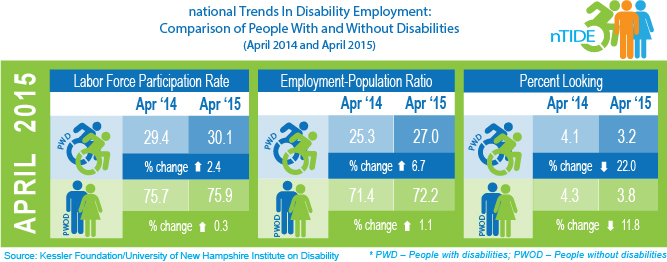DURHAM, NH – May 8, 2015. Positive news continues as Americans with and without disabilities are participating in the labor force and finding jobs, according to today's National Trends in Disability Employment – Monthly Update (nTIDE), issued by Kessler Foundation and University of New Hampshire’s Institute on Disability (UNH-IOD). Social enterprise is one example of a successful strategy that is expanding opportunities for job seekers with disabilities.
In the Bureau of Labor Statistics’ Jobs Report released Friday, May 8, the employment-to-population ratio for working-age people with disabilities increased from 25.3 percent in April 2014 to 27.0 percent in April 2015 (up 6.7 percent; 1.7 percentage points). For working-age people without disabilities, the employment-to-population ratio increased slightly from 71.4 percent in April 2014 to 72.7 percent in April 2015 (up 1.1 percent; 0.8 percentage points). The employment-to-population ratio, a key indicator, reflects the percentage of people who are working relative to the total population (the number of people working divided by the number of people in the total population multiplied by 100). In comparison to April 2014, 337,000 more Americans with disabilities are in the workforce.

“This is encouraging news and bodes well for the approaching 25th ADA anniversary. May positive trends continue in May and beyond,” according to Hugh Berry, research analyst at the National Institute on Disability, Independent Living and Rehabilitation Research (NIDILRR).
For people with disabilities, the labor force participation rate also increased from 29.4 percent in April 2014 to 30.1 percent in April 2015 (up 2.4 percent; 0.7 percentage points). For people without disabilities, the labor force participation rate increased slightly from 75.7 percent in April 2014 to 75.9 percent in April 2015 (up 0.3 percent; 0.2 percentage points). The labor force participation rate is the percentage of the population that is working or actively looking for work.
“It is interesting to see improvements in the employment status of both people with and without disabilities. In the past few months, only people with disabilities have had improving employment status,” said Andrew J. Houtenville, Ph.D., associate professor of economics and research director at UNH-IOD.
Kessler Foundation develops strategies to create and expand employment opportunities for people with disabilities through its national Signature Grants programs. On April 28, the Foundation hosted, “Social Innovation Boot Camp: Building Entrepreneurship and Innovation Capacity to Help Sustain Services in Today’s Human Service Sector,” for grantees and other disability-focused non-profit agencies. Jeffrey A. Robinson, Ph.D., of the Center for Urban Entrepreneurship & Economic Development, the keynote speaker, discussed how to build social enterprises—businesses or organizations that address social issues. According to Dr. Robinson, funding methods include traditional fundraising and grants as well as acquiring private investors, charging fees for service, developing crowd funding and social procurement.
“Kessler Foundation is a leader in funding initiatives that improve employment outcomes for people with disabilities; a growing trend is social enterprise,” said Elaine E. Katz, senior vice president of Grants & Communications. “Social enterprises have the capacity to hire large numbers of individuals who receive market wages. We work with our grantees to develop strategies for success and best practices so that the initiatives can be scaled and replicated for a greater impact.”
In April 2015, among workers ages 16-64, the 4,247,000 workers with disabilities represented 3.0 percent of the total 140,116,000 workers in the U.S.
“The statistics in nTIDE are not seasonally adjusted,” noted Dr. O’Neill. “Because disability employment data have been collected for so few years, more time is needed for seasonal trends to become evident.”
The next nTIDE will be issued on Friday, June 5, 2015.
NOTE: The statistics in the National Trends in Disability Employment – Update are based on Bureau of Labor Statistics numbers, but are NOT identical. They have been customized by the University of New Hampshire to efficiently combine the statistics for men and women of working age (16 to 64).
nTIDE is funded, in part, by grants from the National Institute on Disability, Independent Living and Rehabilitation Research (NIDILRR) (H133B130015 & H133B120005) and Kessler Foundation.
The Institute on Disability (IOD) at the University of New Hampshire was established in 1987 to provide a university-based focus for the improvement of knowledge, policies, and practices related to the lives of persons with disabilities and their families. Its mission is to promote full access, equal opportunities, and participation for all persons by strengthening communities and advancing policy and systems change, promising practices, education, and research.
The University of New Hampshire, founded in 1866, is a world-class public research university with the feel of a New England liberal arts college. A land, sea, and space-grant university, UNH is the state's flagship public institution, enrolling 12,200 undergraduate and 2,300 graduate students.
